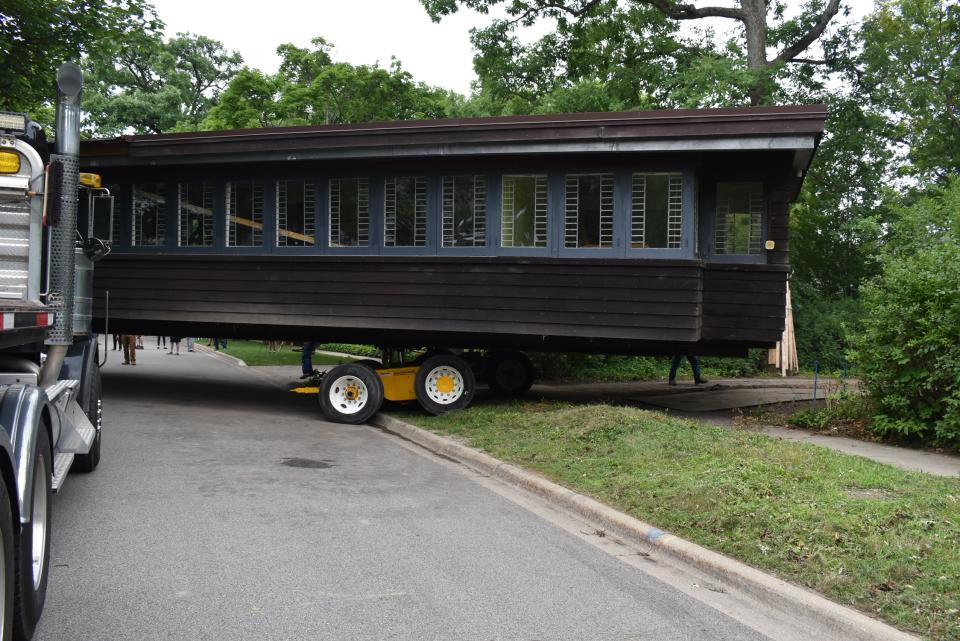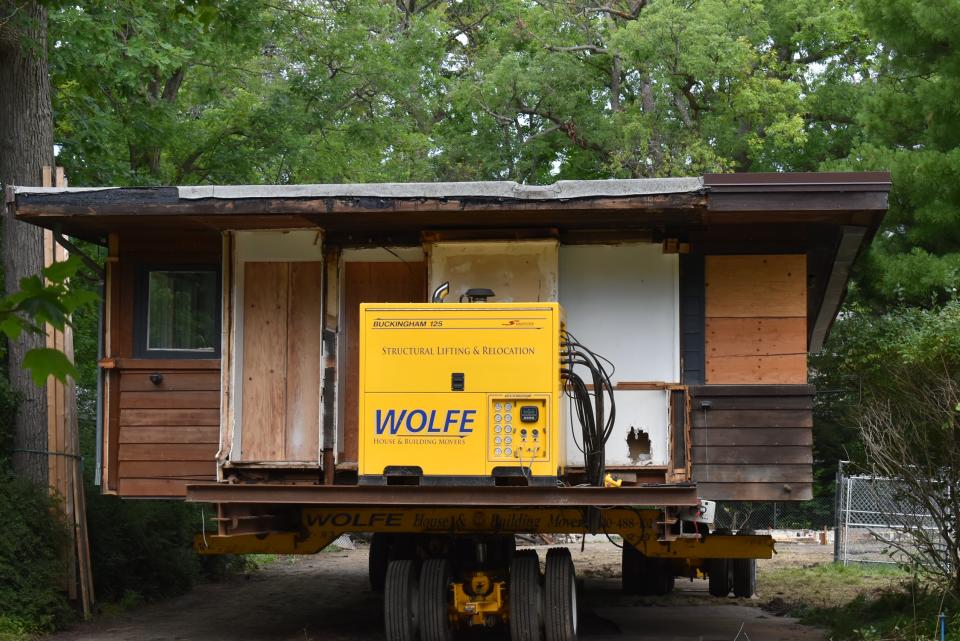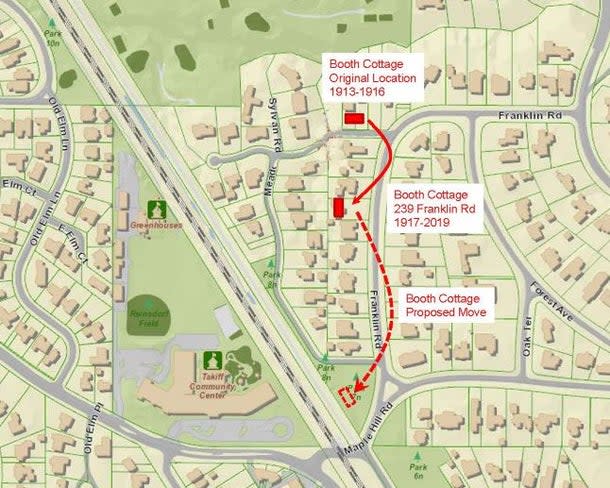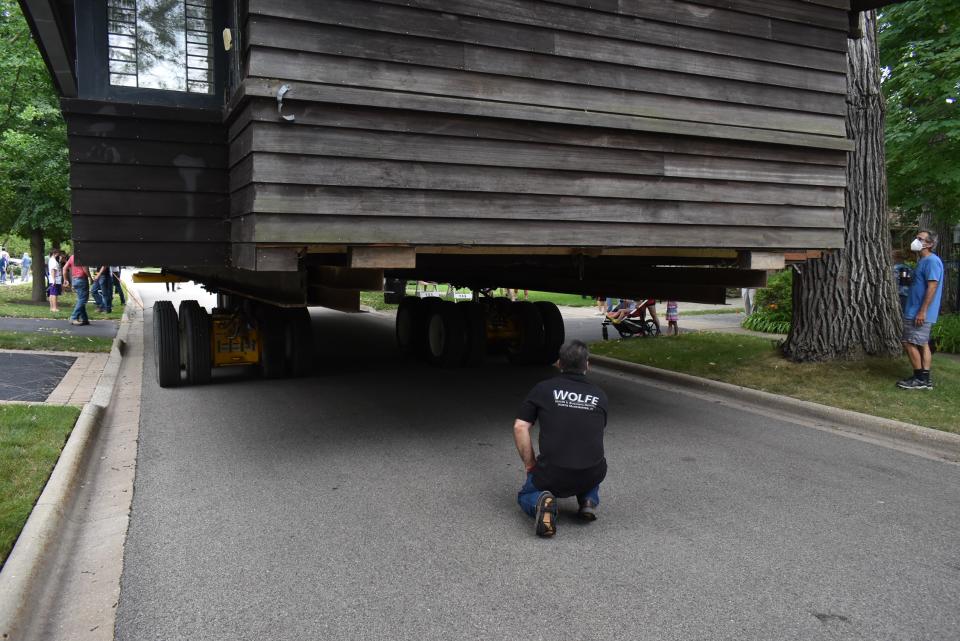Saved From Wrecking Ball, Frank Lloyd Wright House Moved To Park
GLENCOE, IL — The Frank Lloyd Wright-designed Booth Cottage was successfully relocated for the first time in a century thanks to efforts by preservationists and public bodies to save it from potential demolition.
The Glencoe Historical Society organized Tuesday's move of the 105-year-old structure a few blocks down Franklin Road to the southwestern corner of Park 7N. The land at the intersection of Maple Hill, Franklin and Meadows roads is owned by the Glencoe Park District, but the local nonprofit historical society covered the cost of the house's relocation and restoration with the help of tens of thousands of dollars in donations.
A crew from Pennsylvania-based Wolfe House & Building Movers lifted the structure onto three multi-wheel power dollies before a truck slowly brought the one-story home down the driveway and about 750 feet to the south.

"This is one of the days we'll look back and just sort of smile at," said project manager Ed Goodale, a former president of the Glencoe Historical Society. He said the past year had been tortuous at times, but seeing the cottage roll into the park was extremely fulfilling.
"Over the last year it's been sort of an emotional rollercoaster trying to save this house and today it was definitely a high point," Goodale said. "It was really wonderful to see this house come off of its old site and onto its new location. We are absolutely thrilled and very thankful to all of the stakeholders that are involved in this."

The Booth Cottage was originally erected on Sylvan Road in 1913 as a temporary home for Elizabeth and Sherman Booth while Wright built the Prairie-style Booth House at 265 Sylvan Road, which sold in December for $750,000. The smaller cottage was moved a few hundred feet south to 239 Franklin Road in 1917.
Wright's utilitarian design for the cottage offered a preview the subsequent development of his "Usonian" style, which aimed to become an affordable and distinctly American architectural style — its name is derived from the "United States of North America," according to the Frank Lloyd Wright Foundation.
Elizabeth Booth, a leading advocate for expanding voting rights to women, was present at the signing of the Suffrage Bill in Illinois the same year the house was completed. Her husband, Sherman, was Wright's attorney and a founding member of the Glencoe Park District.
At first, they planned to build a 15-acre estate and combine it with a nature preserve designed by influential landscape architect Jens Jensen. Due to financial considerations, the owners decided to build a subdivision with over two dozen homes to be designed by Wright. Only six were completed in Ravine Bluffs subdivision.

Earlier:
Threatened Frank Lloyd Wright House In Glencoe Could Be Preserved
Glencoe Accepts Application To Demolish Frank Lloyd Wright House
'Endangered' Frank Lloyd Wright Home In Glencoe Sold For $550,000
2 Historic Glencoe Homes Among 'Most Endangered' Places In State
Glencoe contains the world's third-largest concentration of structures designed by Wright, according to the historical society. The park where the cottage was moved was originally part of the Booth's property and also contains a bridge and other architectural markers dating back to the original subdivision.
The Booth Cottage was purchased in 1956 by the late architect Meyer Rudoff and art teacher Doris Rudoff. In 1996, the Glencoe Historic Preservation Commission granted it honorary landmark status, which did not preclude its potential demolition but instead mandated a nearly six-month waiting period before demolition.
In October 2017, the Rudoffs' daughter listed the house for $1 million. Despite some inquiries, the landmark status was never upgraded to "certified." In May 2019, the property was purchased by Jean Yang and Justin Lu for $550,000, shortly after the preservation nonprofit Landmark Illinois listed it among the "most endangered historic places in Illinois."
Just over 10 days after closing on the historic home, the new owners filed paperwork seeking a demolition permit and declined to attend any meetings about the property until the 180-day countdown had begun.
In response, the Frank Lloyd Wright Building Conservancy issued a request for proposals to relocate the home. The historical society's proposal was the clear choice, Goodale said.
"One of the huge benefits we have is that we're in town, we're in Glencoe," he said. "We don't do this very often — but preserving, documenting, disseminating the history of Glencoe are our multiple missions"

In January, the Glencoe Park District approved a 99-year lease with the historical society set to pay $1 a year for rent and the village covering the cost of about $15,000 worth of infrastructure. The COVID-19 pandemic delayed the move itself for several months.
Before the house was relocated, some portions of the cottage that were not part of the original design were removed. An overhang over the entrance, a pair of bedrooms added to the rear and an attached garage were all cleared out.
Following up to four months of exterior work, historical society representatives hope to have the building open to the public as a small museum space and research center by summer 2020.

This article originally appeared on the Winnetka-Glencoe Patch

